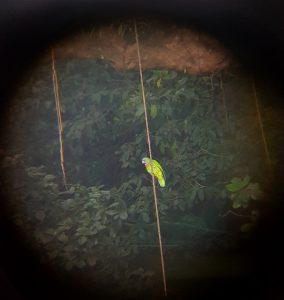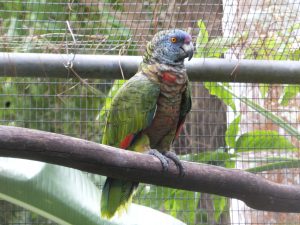This summer, I worked with Professor Lizabeth Paravisini on determining the reasons for the endangered status of several species of Caribbean parrots and documenting the efforts that are being made to conserve them. The research we conducted will serve as the foundation of Professor Paravisini’s newest book, an environmental biography that will inform readers of the history of Caribbean parrots and macaws. We began the project focusing on the parrots of Cuba, Dominica and St. Lucia before shifting our focus to attempting to piece together the history of the Caribbean macaws, which are now all extinct.
We spent most of the month of June traveling between Cuba, Dominica and St. Lucia, conducting interviews with prominent figures in parrot conservation. Since we had entered this phase of the project with several concrete theories about the factors that led the Caribbean parrots to become endangered, our focus was on the efforts to conserve the parrots species.
Arriving in Cuba, we quickly realized that the laws protecting their parrot population are loosely enforced, doing little to reduce the local parrot trade. Consequently, upon showing interest in the parrot population, Professor Paravisini and I were repeatedly asked if we wanted to purchase a parrot. This is particularly disheartening considering that the parrot population in Cuba is slowly decreasing. Through conversations with forestry officials, we were informed that one of their active conservation projects involves using artificial nests to promote breeding among the parrots since they nest in pre-existing tree cavities. This was a strategy we also noticed in St. Lucia and Dominica, with varying degrees of success.
In comparison, over the course of our time in St. Lucia and Dominica, it was easy to see the booming numbers of their parrot species. We were aware of an educational campaign that began in the 1970’s and 80’s, when the parrot species on both islands was at a dangerous low. Through our research, we found out that in Dominica, the forestry department began the parrot conservation efforts earlier than that, when one of their parrot species became a national symbol upon Dominica’s independence. We heard from several people that parrots had been spotted flying over the ocean in Dominica and were starting to become a pest for farmers in both countries, testaments to the increase in the population of parrots.

Amazona aurausiaca, Dominica’s red-necked parrot, spotted through a telescope in the Syndicate National Park.
In July, I was tasked with collecting all the information that was available through the Internet on the Caribbean macaws. This was a daunting task because all of them have been extinct for centuries, and most of them are categorized as “hypothetical” species. They are categorized in this way because there aren’t any fossils or skins of the macaws to scientifically support their existence, only brief descriptions written during the colonial period. Although most of the literature on the “hypothetical” macaws refutes their existence by comparing their descriptions to those of birds from other nearby islands, I was able to find the original descriptions as well as several depictions of macaws in paintings of European courts that match the descriptions of the “hypothetical” macaws. This finding was exciting because it supports Professor Paravisini’s theory that Christopher Columbus took several species of Caribbean macaws to European courts and to be traded, beginning the demise of the species.
Participating in this project was an incredible experience. It was inspiring to hear so many success stories and to have been a part of the first attempt to piece together the history of these birds.


